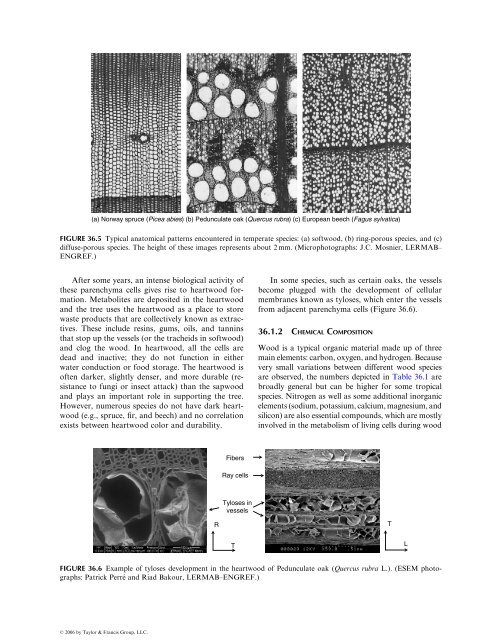36 Drying of Wood
36 Drying of Wood
36 Drying of Wood
- No tags were found...
You also want an ePaper? Increase the reach of your titles
YUMPU automatically turns print PDFs into web optimized ePapers that Google loves.
(a) Norway spruce (Picea abies) (b) Pedunculate oak (Quercus rubra) (c) European beech (Fagus sylvatica)FIGURE <strong>36</strong>.5 Typical anatomical patterns encountered in temperate species: (a) s<strong>of</strong>twood, (b) ring-porous species, and (c)diffuse-porous species. The height <strong>of</strong> these images represents about 2 mm. (Microphotographs: J.C. Mosnier, LERMAB–ENGREF.)After some years, an intense biological activity <strong>of</strong>these parenchyma cells gives rise to heartwood formation.Metabolites are deposited in the heartwoodand the tree uses the heartwood as a place to storewaste products that are collectively known as extractives.These include resins, gums, oils, and tanninsthat stop up the vessels (or the tracheids in s<strong>of</strong>twood)and clog the wood. In heartwood, all the cells aredead and inactive; they do not function in eitherwater conduction or food storage. The heartwood is<strong>of</strong>ten darker, slightly denser, and more durable (resistanceto fungi or insect attack) than the sapwoodand plays an important role in supporting the tree.However, numerous species do not have dark heartwood(e.g., spruce, fir, and beech) and no correlationexists between heartwood color and durability.In some species, such as certain oaks, the vesselsbecome plugged with the development <strong>of</strong> cellularmembranes known as tyloses, which enter the vesselsfrom adjacent parenchyma cells (Figure <strong>36</strong>.6).<strong>36</strong>.1.2 CHEMICAL C OMPOSITION<strong>Wood</strong> is a typical organic material made up <strong>of</strong> threemain elements: carbon, oxygen, and hydrogen. Becausevery small variations between different wood speciesare observed, the numbers depicted in Table <strong>36</strong>.1 arebroadly general but can be higher for some tropicalspecies. Nitrogen as well as some additional inorganicelements (sodium, potassium, calcium, magnesium, andsilicon) are also essential compounds, which are mostlyinvolved in the metabolism <strong>of</strong> living cells during woodFibersRay cellsTyloses invesselsRTTLFIGURE <strong>36</strong>.6 Example <strong>of</strong> tyloses development in the heartwood <strong>of</strong> Pedunculate oak (Quercus rubra L.). (ESEM photographs:Patrick Perré and Riad Bakour, LERMAB–ENGREF.)ß 2006 by Taylor & Francis Group, LLC.
















